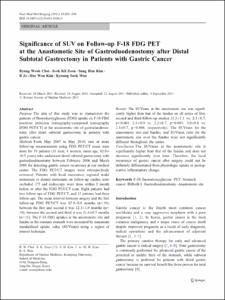KUMEL Repository
1. Journal Papers (연구논문)
1. School of Medicine (의과대학)
Dept. of Nuclear Medicine (핵의학)
Significance of SUV on Follow-up F-18 FDG PET at the Anastomotic Site of Gastroduodenostomy after Distal Subtotal Gastrectomy in Patients with Gastric Cancer
- Keimyung Author(s)
- Zeon, Seok Kil; Kim, Hae Won; Won, Kyoung Sook
- Department
- Dept. of Nuclear Medicine (핵의학)
- Journal Title
- Nuclear Medicine and Molecular Imaging
- Issued Date
- 2011
- Volume
- 45
- Issue
- 4
- Keyword
- F-18 fluorodeoxyglucose; PET; Stomach cancer; Billroth I; Gastroduodenostomy; Anastomotic site
- Abstract
- Purpose The aim of this study was to characterize the
patterns of fluorodeoxyglucose (FDG) uptake on F-18 FDG
positron emission tomography/computed tomography
(FDG PET/CT) at the anastomotic site of gastroduodenostomy
after distal subtotal gastrectomy in patients with
gastric cancer.
Methods From May 2007 to May 2010, two or more
follow-up measurements using FDG PET/CT scans were
done for 19 patients (11 men, 8 women; mean age, 62.0±
10.3 years) who underwent distal subtotal gastrectomy with
gastroduodenostomy between February 2006 and March
2008 for detecting gastric cancer recurrence at our medical
center. The FDG PET/CT images were retrospectively
reviewed. Patients with local recurrence, regional nodal
metastasis or distant metastasis on follow-up studies were
excluded. CT and endoscopy were done within 1 month
before or after the FDG PET/CT scan. Eight patients had
two follow-ups of FDG PET/CT, and 11 patients had three
follow-ups. The mean interval between surgery and the first
follow-up FDG PET/CT was 12.9±0.8 months (n=19);
between the first and second it was 12.3±1.0 months (n=
19); between the second and third it was 11.6±0.7 months
(n=11). The F-18 FDG uptakes at the anastomotic site and
fundus in the remnant stomach were measured by maximum
standardized uptake value (SUVmax) using a region of
interest technique.
Results The SUVmax at the anastomotic site was significantly
higher than that of the fundus on all series of first,
second and third follow-up studies (3.3±1.1 vs. 2.1±0.7,
p<0.001: 3.1±0.9 vs. 2.2±0.7, p=0.001: 3.0±0.6 vs.
2.1±0.7, p=0.006, respectively). The SUVmax for the
anastomotic site and fundus, and SUVmax ratio for the
anastomotic site over the fundus were not significantly
different throughout the series.
Conclusion The SUVmax at the anastomotic site is
significantly higher than that of the fundus and does not
decrease significantly over time. Therefore, the local
recurrence of gastric cancer after surgery could not be
definitely differentiated from physiologic uptake or postoperative
inflammatory change.
Keywords F-18 fluorodeoxyglucose . PET. Stomach
cancer . Billroth I . Gastroduodenostomy. Anastomotic site
- Publisher
- School of Medicine
- Citation
- Byung Wook Choi et al. (2011). Significance of SUV on Follow-up F-18 FDG PET at the Anastomotic Site of Gastroduodenostomy after Distal Subtotal Gastrectomy in Patients with Gastric Cancer. Nuclear Medicine and Molecular Imaging, 45(4), 285–290. doi: 10.1007/s13139-011-0105-9
- Type
- Article
- ISSN
- 1869-3474
- Appears in Collections:
- 1. School of Medicine (의과대학) > Dept. of Nuclear Medicine (핵의학)
- 파일 목록
-
-
Download
 oak-aaa-04003.pdf
기타 데이터 / 230.61 kB / Adobe PDF
oak-aaa-04003.pdf
기타 데이터 / 230.61 kB / Adobe PDF
-
Items in Repository are protected by copyright, with all rights reserved, unless otherwise indicated.